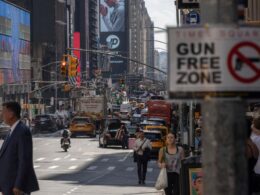Gov. Hochul has stopped a massive, controversial plan to expand Penn Station by demolishing the adjoining Block 780. While saving a neighborhood is good news, stopping that flawed plan isn’t enough. It’s time to tackle the real reason Penn Station is so chaotic and frustrating: no single entity is truly in charge.
Penn Station feels like three different train companies operating in the same cramped space, barely talking to each other. That’s because, essentially, they are.
Amtrak technically owns the station and runs trains connecting cities up and down the East Coast. But the MTA runs the Long Island Rail Road bringing commuters from the east, and soon Metro-North trains from the north. And NJTransit brings in waves of commuters from the west. Each has its own goals, its own schedules, its own tickets, and its own way of doing things.
This isn’t how it always was. When the original, grand Pennsylvania Station opened in 1910, one company — the Pennsylvania Railroad — designed, built, and ran the whole show. It had a clear vision. Today’s setup, with competing priorities, leads directly to the problems passengers face every day: confusing signs, difficulty transferring between trains, schedules that don’t line up, and a generally stressful experience.
This management muddle doesn’t just inconvenience riders; it wastes billions of taxpayer dollars. For instance, there’s a common-sense idea called “through-running” — letting NJT trains continue straight through Penn Station to Long Island or Connecticut, and vice-versa, instead of hitting a dead end. This would free up precious platform space, reduce crowding, and create seamless regional travel.
But with three separate agencies guarding their turf, ideas that benefit the whole system get stuck. Agencies plan upgrades for their own lines without coordinating, sometimes even creating new conflicts. The recently halted expansion plan, despite costing billions, was pushed forward with major flaws because there was no single authority looking out for the best interests of the entire network, just individual agency wish lists.
Other major world cities faced similar challenges and found a solution: unified management. In London, one organization (Transport for London) coordinates the Underground, buses, and commuter rail. Everything works together — schedules, fares, information — making it much easier to get around, and leading to a huge jump in people using public transport.
Paris, Berlin, and Toronto have done similar things, proving that one coordinated system works far better, even with different companies actually running the trains. They realized that a connected network needs connected leadership.
Sticking to the status quo means sticking with the confusion and inefficiency that frustrates millions of passengers and holds back our region. Working together under a coordinated system doesn’t mean these agencies lose their expertise; it means their expertise contributes to a system that actually works smoothly for everyone. London’s example shows that different operators can thrive under unified planning.
So, what’s the path forward? New York, New Jersey, and Connecticut need to create a new regional rail authority through a formal agreement (sometimes called an interstate compact), with federal support. This new body must have the power to:
- Create a seamless passenger experience: Think unified fares, easy-to-understand information systems across all trains, and maybe even consistent branding.
- Coordinate train operations: Make schedules work together across LIRR, NJT and Metro-North.
- Make smart investment decisions: Prioritize projects based on what benefits the entire region, not just one agency’s needs.
- Have the final say: Make binding decisions on how tracks are used and services are run, ensuring everyone works together.
This new authority needs fair representation from all players, but no single agency should be able to block progress for the whole system.
This isn’t just about fixing today’s headaches. Billions are being spent on the Gateway Program to build new tunnels under the Hudson, which will double the number of NJT trains that can reach Penn Station. Without fixing the management mess inside the station first, we won’t be able to handle those trains effectively. We’ll have more capacity leading into the same old bottleneck.
Hochul showed courage by stopping the flawed expansion plan. Now, she has a historic opportunity to address the root problem. By creating a single, empowered authority to manage Penn and our regional rail network, she can ensure that future investments truly serve the millions of people who rely on this vital hub every year. It’s time to end the chaos and build a system worthy of our region.
Blank is the transportation committee chair at The City Club of New York. Previdi has been a planner and spokesperson for NYC Transit, the MTA, and the Philadelphia City Council.








